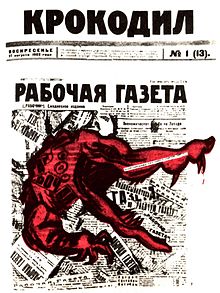Crocodile (magazine)
Krokodil ( Russian Крокодил ) was a Soviet / Russian satirical magazine . It was first published on June 4, 1922, initially by the Rabotschaja Gazeta publishing house ( Рабочая газета , workers' newspaper ). From 1932 the magazine was published by Pravda , the main publisher of the Communist Party . Krokodil appeared weekly until 1932 , then three times a month. Features, humorous stories and caricatures were published.
In the 1920s, there were numerous satirical magazines in the Soviet Union in addition to Krokodil . After massive political and ideological attacks on "bourgeois satire", which served the New Economic Policy ( NEP ), censorship bans and bans on other magazines in the incipient Stalinism , from 1930 on, Krokodil remained the only officially approved satirical magazine that was distributed throughout the Soviet Union. The significance of satire for the Soviet regime becomes clear when one compares the fate of the official crocodile and the literary group OBERIU persecuted by the regime , to which writers such as Daniil Charms , Alexander Vvedensky and Nikolai Oleinikov belonged.
From 1930 on, Krokodil became the most important official mouthpiece of Soviet ideology at all levels of socio-political life. "The satire" of the crocodile was not limited to small everyday topics, but reflected the key questions and the central events of domestic and foreign policy, from accusations against Leon Trotsky , against alleged spies and enemies of the people in the 1930s to attacks against West German revanchism , American imperialism and its satellites, colonialism , etc. in the post- 1945 Cold War era .
Until the beginning of perestroika , the crocodile publications were extremely aggressive. Krokodil pursued the policy of official anti-Semitism , including the hunt against cosmopolitans : numerous repulsive, humiliating, openly anti-Semitic caricatures and comments by the crocodile accompanied the alleged doctors' conspiracy and attacked the murderers in white coats (see e.g. Krokodil, 1953, no. 3). In 1963, the prominent film director Mikhail Romm expressed himself with utter horror about an insulting caricature published in Krokodil on March 20, 1949, which depicted a figure with apparently Semitic facial features who was holding a book on which the inscription Zhid ( жид , Dreckjude ) was recognizable. Romm emphasized: not André Gide [ Андре Жид ] , but just like that: 'Filthy Jew' [ жид ].
In the age of perestroika, Krokodil began to take action against sloppiness and lazy bureaucrats, and the issue of alcohol also moved into focus. Caricatures against religion and also the imperialist threat remained - even the Chernobyl nuclear disaster in 1986 was dubbed an exaggerated American smear campaign. It was not until 1987 and 1988 that the authors became more courageous and drew against grievances.
In 2000 the magazine was discontinued for financial reasons. In 2005 there was an attempt at recovery under the title “Новый Крокодил” (New Crocodile). This was discontinued in 2008.
Web links
- Web journal since 2006 ( Memento from August 14, 2007 in the Internet Archive ) (Russian)
- Caricatures from Crocodile (1953–1999) (Russian)
- "Krokodil" magazine. Archive 1924–1991 (Russian)
Individual evidence
- ↑ AW Bljum: Za kulisami "Ministerstva pravdy". Tajnaja istorija sovetskoj cenzury (Behind the Scenes of the “ Ministry of Truth”. The Secret History of Soviet Censorship), St. Petersburg 1994
- ^ Benjamin Pinkus: The Soviet Government and the Jews. 1948-1967. A documented study. General Editor: Jonathan Frankel. Cambridge, 1984, p. 112-113
- ^ Paul Roth: The Caricature in Russia in the Late Soviet and Post-Soviet Period (1985–1995) , accessed on February 10, 2015
- ↑ Internet edition of the Voice of Russia ( Memento of October 20, 2007 in the Internet Archive )
- ↑ Article on Media-Atlas.ru , accessed on February 10, 2015
